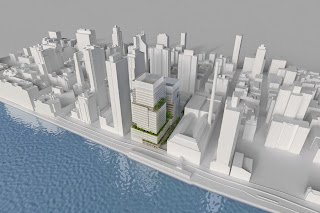The city sold the 66,000 square-foot site at 525 East 73rd Street -- formerly home to a Department of Sanitation garage that was demolished in 2008 -- for $226 million, to construct the new state-of-the-art science and medical facilities.
At the time, then Mayor Bloomberg called the deal “easily one of the largest real estate transactions the city has ever been involved in.”
Memorial Sloan-Kettering Cancer Center will construct an up to 750,000 square-foot cancer care facility and CUNY Hunter College will build a 403,000-square-foot Science and Health Professions building to upgrade its science and nursing facilities. [See ElectricWeb | Blogger, Mar 6, 2013]
Preliminary work has already begun at the site, with construction planned to begin in 2014. The project, which is slated for completion in 2018, will create more than 3,200 construction jobs and nearly 830 permanent jobs according to the New York City Economic Development Corporation.
“Thanks to our innovative approach to economic development, today’s announcement is yet another step towards making New York City home to the world’s most talented workforce,” Bloomberg said.
“Not only will these two great institutions play a critical role in creating great jobs in one of the city’s growing industries, but they usher in the innovators and medical advancements of tomorrow.”
The Memorial Sloan-Kettering Cancer Center will be well-positioned near the hospital’s main campus at 1275 York Avenue and will provide outpatient treatment programs for patients with lung, head, neck and hematological cancers and will include state-of-the-art outpatient bone marrow transplantation services.
The site will also enable CUNY Hunter to create consolidated science and nursing facilities, eliminating the need for duplicate eating halls, libraries and other facilities at the current 25th Street campus, which will ultimately be vacated.
Visit Our Sponsors
Page Views
Since October 1, 2011










